Ultra High K
Andesites of Continental Interiors
The South American Interior
New or old centres lying on the continental side of the active chain or in locations where two continental blocks are in collision as in Tibet, Iran, Turkey, the Highwood Mts, Challis Mts, Bearpaw Mts, the Shonkin Sag, western Argentina (Cerro Pocho and Cerro Tuzgle), Tambora on the continental side of Sumbawa in the East Indies and in the Roman Province (Mt Vesuvius) may have 5-8% K2O and correspondingly high Rb, Ba, Th, U, which can be enriched by a factor of 20-50 above enriched MORB or x 30-60 mantle, while Cs may be as much as much as 200-300 times mantle.
It is assumed that the sub-crustal mantle has become enriched in LILE (Large-ion lithophile elements, or incompatible elements, during the subduction process but not in Nb, Ta, Y and the heavy REE . There are no known examples of calc-alkaline, orogenic andesites not having the characteristic fingerprint as shown below, however most other continental rocks including flood basalts share it as do all continental granites, granodiorites, diorites and lamprophyres.
 |
Cerro Tuzgle potassic andesite, Argentina. |
The North American Interior
Yellowstone, and the Highwood Mts
Far to the east on the eastern flank of the Rockies, Yellowstone Park is a centre for rhyolitic and basaltic volcanism and in Montana are the Highwood Mts, Bearpaw Mts, Leucite Hills, & the Shonkin Sag Lopolith all notable for highly potassic rocks. The Shonkin Sag is differentiated into a mafic rock, (Shonkinite) and a felsic or syenitic residue. Nevertheless, all have classic orogenic andesite fingerprints.
 |
Shonkin Sag lopolith, Wyoming, fingerprint.
Note similarity to other potassic andesites such as Mt Vesuvius, Cerro Tuzgle, Tambora, Challis Mts. |
 |
Archean potassic andesites from Chibougamau, Quebec Canada.
This rock is archean of at least 2.7Byr
- obviously geochemical processes have not changed in that time. |
 |
The modern highly potassic Challis volcanics of Idaho. |
Most of the other volcanic areas described from the Western USA including the Rio Grande Rift show signatures typical of continental crust. These include the Southern Basin and Range, (Bradshaw, Hawkesworth & Gallager, 1993), the Mongollon-Dalil V. Field of N. Mexico, (Davis & Hawkesworth, 1993); the Latir Vol. Field in the Rio Grande Rift (Johnson & Liipman,1988); the Northern Basin and Range Basalts, (Draper,1991) (which seem to have abnormally low P); the Summer Coon Basalts of San Juan, Col. (Zielinski & Lipman, 1976); the Serviletta Basalts of the Taos plateau, (Dungan et al, 1986; also McMillan & Dungan, 1988; also Aoki, 1967). These latter rocks usually termed tholeiites are rather akin to the Columbia River Flood basalts.
Time, space and finance does not allow a complete discussion of all these provinces as yet.
The Roman Province
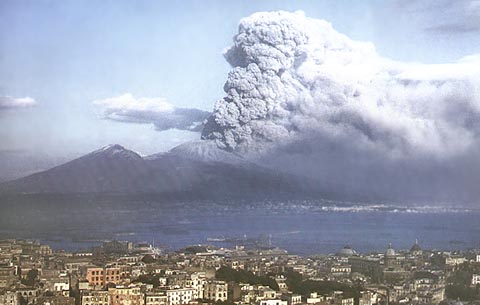
Vesuvius during a classic andesitic eruption.
|
|
Mt Vesuvius, ultra potassic example. Note Rb, Ba etc at 20-50 times E-type levels. |
|
|
Ultrapotassic "Rhyolites" (actually closer to Trachytes) from Campi Phelegri, Naples, Roman province.
These are the highest evolved of the Roman magmas. Note the titanium has gone with titanomagnetite, P & Sr are dropping rapidly . Rb having dropped with leucite is building ip again with the formation of sanidine, but the Ba is dropping rapidly. The Nb anomaly is still visible though being made less dramatic as Nb builds up, REE, Zr, Y are still residual. |
 |
Mg variation diagram for Mt Vesuvius historic lavas. Note the very high K2O, the low TiO2 indicative of calc-alkaline andesite suites, and the straight trends due to pyroxene fractionation. Data of USGS, courtesy of Harvey Belkin.
|
Other, non-active and prehistoric volcanic areas in the Roman province are similar to Vesuvius, have the same fingerprint and are equally potassic. Peccerillo et al, (1984) include Cs in their Alban Hills data. At 200 times E-type or >60ppm, these are the most Cs enriched rocks known. Others, especially Vulsini (Parker, 1989), and Sabatini (Conticelli et al, 1997) show very high Th enrichment, in the range 60-200 x EMORB or >100 ppm with Rb at >600ppm. Sr is unusually high (up to 1600ppm). Perhaps the presence of nepheline rather than sodic plagioclase is responsible.
The more basic members. like Vesuvius, appear to be dominated by clinopyroxene fractionation, which, at close to 52% silica, desilicates the magma while greatly increasing the LILE. Montefiasconi (Di Battistini et al, 1998) and Roccamonfina, (Gianetti and Elam, 1994) also appear to differ from Vesuvius only in minor detail, but not all the same elements have been determined for all regions.
 |
Vulsini. While unfortunately with no REE, this series shows the progressive decline in Ti, P very well, with Ba just beginning to decline and other elements regularly increasing with fractionation. |
 |
The Campanian Ignimbrites. These show one of the best examples to be found of the effects of fractionation. These rocks are beyond the TiMt point and Ti remains low and constant. P declines while REE, Nb, Zr, Y increase. With the appearance of sanidine, K declines slightly but Sr and Ba quite catastrophically. Mechanical separation of phenocrysts while the ejecta is air-borne, is possible. |
 |
Roccamonfina Volcano, Italy |
 |
Potassium rich Alban Hills near Rome. |
 |
Latera Caldera, Italy |
 |
Montefiascone complex, Rome |
 |
Neopolitan Yellow Tuff, Rome |
The Aeolian Arc
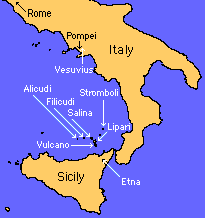 The Aeolian Arc is the name give to a group of half a dozen calc-alkaline islands to the north of the large island of Sicily, Italy, about 150 miles south of Mt Vesuvius and bordering the Tyrrhenian Sea. They are usually given the name of one of the islands and called the Lipari Group. The Aeolian Arc is the name give to a group of half a dozen calc-alkaline islands to the north of the large island of Sicily, Italy, about 150 miles south of Mt Vesuvius and bordering the Tyrrhenian Sea. They are usually given the name of one of the islands and called the Lipari Group.
Salina is the least LILE enriched but shows the widest range of composition, with basalt, basaltic andesite, andesite and dacite. It has mature arc characteristics with a K(60) of 2.0, K/Rb = app. 320, and Zr/Nb ~ 15. It shows a very good Th/U correlation of 2.7 at up to 8ppm Th and a very regular descent in V from 320 to 30 ppm.
Filicudi and Lipari are similar but with slightly higher K, the K(60) being 2.5 and the Zr(60) 120, cf 90.
Alicudi also has a K(60) of 2.5 but has no dacites.
Vulcano which lies closer to the Sicilian mainland, ranges, rather erratically, from basalt to rhyolite and is much more potassic with a K(60) of ~5.0 and is transitional to the Roman province. On an alkali/silica diagram the Vulcanian rocks plot in the Hawaiite-Mugearite-Benmoreiite fields. While the U/Th and Ce/La lie on the same trends as seen in Salina, there is almost no overlap, Vulcano being greatly enriched, the Vulcano basalts having about the same levels of U, Th as the Salina dacites with 15 up to 45 ppm Th. The Vulcano dacites have at least 5 times the Nb seen in Salina. The data of Esperanza et al, (1992, C.Min.Pet.112) and del Moro et al, (1998, Lithos 43) are similar and are combined in the diagram below.
Vulcano is very potassic, approaching Mt Vesuvius with a K(60) of about 5%. By their silica, the rocks are basalt-andesite-dacite with 2 rhyolites. The data of Esperanza et al, (1992, C.Min.Pet 112) and Del Moro et al, (1998, Lithos 43) are similar.
|
|
Salina, Aeolian Arc, Italy (Sicily). Combined data,
(Francalani, et al, 1993; Gertissa & Keller, 2000) |
|
|
Filicudi |
|
|
Alicudi, Aeolian Arc. fairly coherent basalt-basalticandesite-andesite series with K(60)=2.5, K/Rb=328. Th is high, up to 12ppm with K/Th=1940. |
|
|
Lipari. Combined data, (Crisci et al, 1991; Esperanca et al, 1992) |
|
|
|
Stromboli; includes ultra potassic basaltic andesites. |
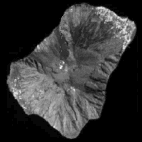
Stromboli via satellite |
 |
Stromboli, EMORB diagram. |
|
|
Vulcano. Combined data, Esperanca et al, 1992: del Moro, 1998) |
|
|
Ternary diagram of N-Mg-K for
Etna (+), Salina (x) and Vulcano (*). |
 |
Aeolian Arc - MgO vs Oxides variation diagram showing the unusually wide variation in K2O. |
 |
Aeolian Arc - La vs REE |
 |
Aeolian Arc - Th vs U |
 |
Aeolian Arc - MgO vs other elements |
 |
Aeolian Arc - MgO vs metals |
| Stromboli appears to consist of only potassic basalts and basaltic andesites with a K(50) of about three. Two sets of data, that of Francalani et al, (1993, C.Min.Pet.113) and from Bull.Vol.Rep. 1993, differ, the latter being basanites but including no trace elements. This island has been almost continuously active since Roman times.
 Stromboli - MgO vs Oxides. Stromboli - MgO vs Oxides.
|
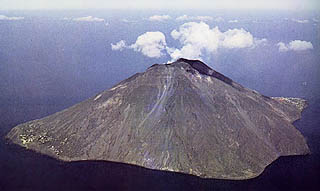 |
Etna
|
Etna lies on the Sicilian mainland and is a massive volcano of frequent eruption. There is a large amount of major element data including pre-historic but little good trace element data.
Compositions lie on the hawaiite-mugearite-benmoreiite fields on an alkali/silica diagram but then so does Vulcano. However, Etna is much more sodic than Vulcano and slightly more so than Salina or Alicudi, plotting fairly close to St Helena. The Ti is very low, the heavy ash cloud is more reminiscent of a calc-alkaline eruption (see pic), and the minor amount of trace element data do show a slight negative Nb anomaly. Until new ICPMS data is to hand we must reserve opinions on Etna though it is probably mainly of Hawaiite composition.
|
 |
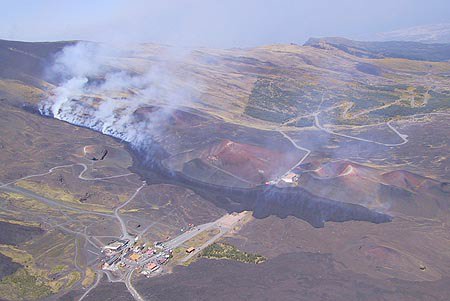
The lowest vent that opened on the south flank of Etna at 2100m a.sl. and
produced a lava flow that destroyed the road to Rifugio Sapienza and
expanded toward the village of Nicolosi. Photo: Sonia Calvari |
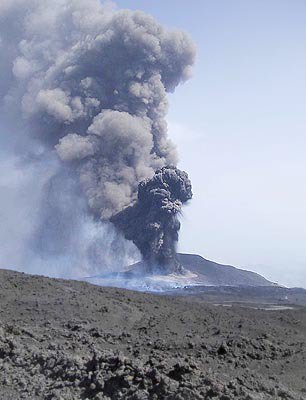 24th of July 2001; activity at Etna's new cone.
24th of July 2001; activity at Etna's new cone.
Photo: Sonia Calvari
|
 |
Santorini, Aegean Arc, Greece. Note the depleted nature of some of the basalts, comparable in fact to some primitive arcs of the ocean basins. It might suggest that the crust is quite thin in the Aegean. Santorini erupted explosively in 1628BC, in what is thought to be the biggest eruption in historic time, and credited with bringing Minoan civilisation to an end. |
The Turkish - Tibetan Plate Boundary

Ararat and Little Ararat. Potassic volcanoes lying north of the junction
of the Arabian Plate and the Anatolian Plate in eastern Turkey.
 |
Potassic and Calc-Alkaline magmas of Tibet. |
 |
Ultra-Potassic orogenic lavas of Tibet. |
Click for requests or comments:
Copyright © 1998-2006 Dr B.M.Gunn
Home
|